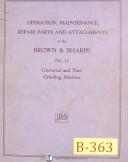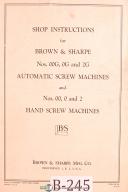- Product Code: #04430009Quantity
Product Description
04430009 TESATRONIC TT20
The 04430009 is Swiss made.
Features:
- 2 probe inputs for single, sum or difference measurements.
- Large LCD display panel, easy to read, reducing errors.
- Choice of analog or bar display.
- Ability to set permissible limit values.
- RS 232 Interface opto-coupled, bidirectional Mains power supply adapter
- Number of Probe Inputs: 1
- Number of Measuring Range Settings: 7
- Lowest Range Value: +/- 5 um
- Highest Range Value: +/- 5000 um
- Numerical Interval: 0.1 um
- Memory: No
The 04430009 has inch/metric conversion.


Brown And Sharpe Amplifier Manual Online
BROWN & SHARPE Model A Turret Drill Drilling Machine Operator & Part Manual $ 30.00 Add to cart; BROWN & SHARPE No. 12 Plain Milling Machine Part Manual $ 55.00 Add to cart; BROWN & SHARPE No. 2 & 2B Surface Grinder Operator’s & Parts Manual $ 45.00 Add to cart; BROWN & SHARPE No. 2 Dynamaster Vertical Mill Parts Manual $ 49.50 Add to cart. Brown and Sharpe 10' Universal Spiral Index Centers Operations Manual: 56: Backner, Brian:: June 1950: Grinder: Brown and Sharpe No. 10 Tool & Cutter Grinder Operation Manual: 63: Backner, Brian:: 1942: Grinder: Brown and Sharpe No. 10 Tool & Cutter Grinder Repair Parts: 14: Backner, Brian:: 1935: Grinder.

Brown And Sharpe Amplifier Manual Free
Continued::
Driven from the base-mounted motor, both spindle types were arranged to run at 3200 r.p.m. (though optionally at 2750 r.p.m. if specified) but when coupled to the direct motor turned at 3450 r.p.m. (with, on this fitting, no option of a slower of faster rate).
As the table drive was all-mechanical, the mechanism employed to produce the automatic reversing left-to-right, right-to-left movements and indexing feeds was a delight to watch in action. Two rates of table travel were available, 19 and 31 feet per minute, selected by a lever behind the longitudinal-feed handwheel. To set the limits of table travel adjustable dogs, carried in a T-slot that ran the full length of the table's front face, caught against a plunger set in the forward part of the manual reversing lever - this plunger able to be withdrawn against a spring to allow, for whatever reason, table movement to go beyond the reversing point but without disturbing the dogs. Set centrally on the saddle, the manual reversing lever was a useful facility when working on very short jobs, just flicking it left and right causing the table to oscillate as required. When operated by hand, one turn of the table's longitudinal handwheel produced a travel of approximately 2' - the wheel able to be disengaged against a spring-plunger for safety reasons when power drive was engaged.
More mechanical delight was to be found in the automatic traverse movement, the limits of its travel being controlled by stop dogs mounted in a T-slot on the saddle's right-hand face. A friction-type arrangement, the automatic cross-feed mechanism could be set to index the feed in, or out, at either or both ends of the table travel - the setting being achieved by two knurled-rim nuts set in partial-circle slots on the face of the unit. Feed rates from 0.01' to 0.09' were available, a large knurled-edge nut in the middle of the assembly being used to engage and disengage the drive; with the mechanism in the latter state the cross-feed could be manually operated without fear of the drive re-engaging.
The spindle head was raised and lowered by a large-diameter handwheel connected to a pair of bevel gears - the horizontal one of which was threaded to take a non-rotating, precision-cut, heat-treated screw. Being of a considerable size, the handwheel rim was used as the micrometer dial, the widely-spaced graduations reading to 0.005'. As an option the makers offered a special fine-feed attachment that allowed the vertical adjustment to be set to just 0.0001' (1/10 of one-thousand of an inch) together with a plunger-type positive stop that could be withdrawn to allow free turning of the wheel . The
Continued below: